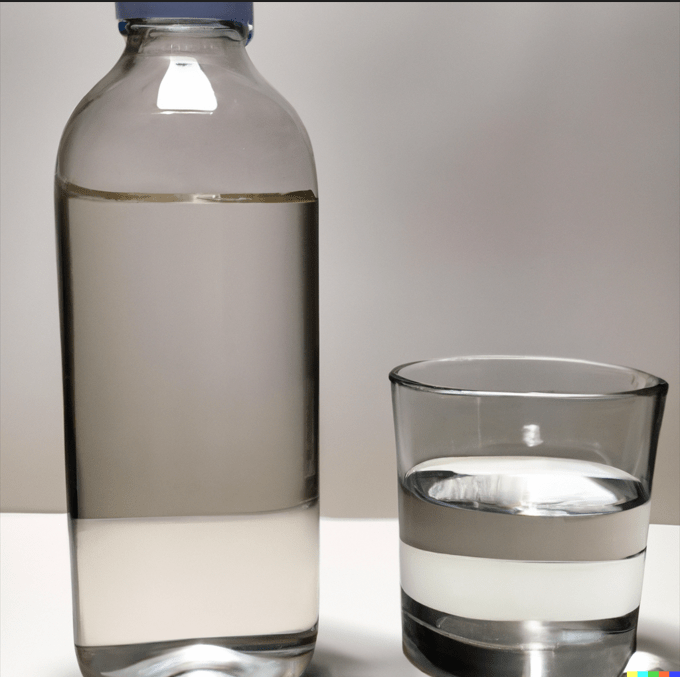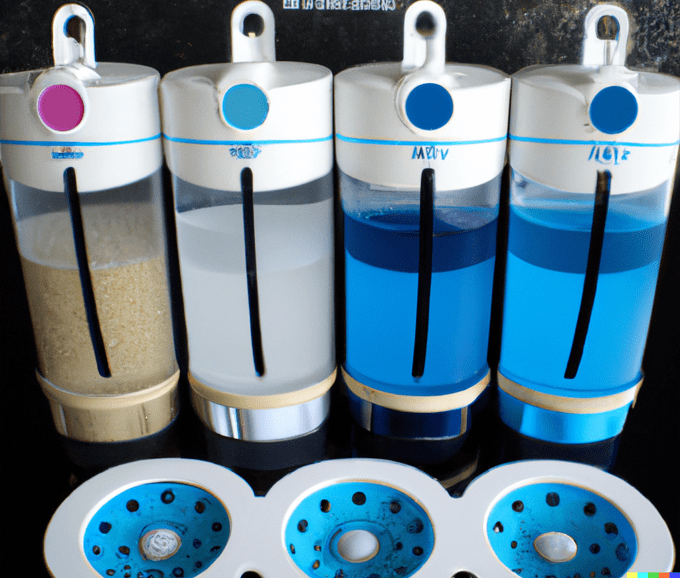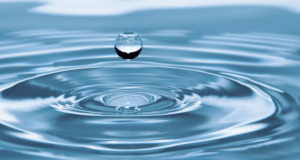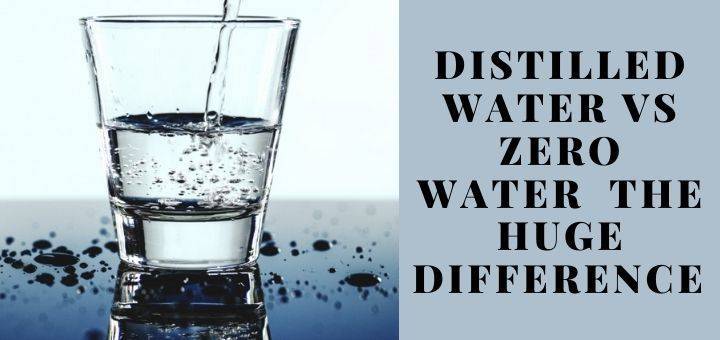Water is a vital component of our daily lives, and it is essential to understand the different forms of water available to us.
Distilled water and zero water are two popular options, but what sets them apart from each other? Distilled water is made by boiling water and turning it into vapor, which is then condensed back into the water.
However, this process leaves distilled water without any minerals, giving it a flat taste.
On the other hand, zero water is produced through a five-stage ion filtration process that removes almost 100% of all substances dissolved in water, including the good minerals like calcium, sodium, and potassium that our bodies need.
This article will delve into the differences between distilled water and zero water, including their processes, tastes, and benefits.
Distilled water vs Zero water

Filtration of Zero water
The filtration process of Zero water is renowned for its unparalleled purification abilities. The five-stage filtration system effectively eliminates all unwanted substances from tap water, leaving you with only pure H2O.
The handheld meter, included with each Zero water pitcher, displays a reading of zero dissolved substances, ensuring that your drinking water is cleaner and healthier.
The first two stages of filtration utilize a coarse filter screen to remove larger particles such as sand. Then, the foam disruptor, activated charcoal, and ion exchange work in unison to remove chlorine, chloroform, and volatile organic compounds (VOCs).
Unlike distilled water, which only turns water into vapor and then condenses it back into the water, Zero water’s five-stage ion filtration guarantees the removal of all contaminants and leaves you with delicious-tasting water.
What is zero water?
Zero water is a five-stage filtered water that utilizes an ion exchange process to eliminate almost 100% of all substances dissolved in water.
Unlike distilled water, the zero water filtration system removes not just the impurities, but also the beneficial minerals such as calcium, sodium, and potassium that the human body requires.
This filtering process differs from distilled water, which is created by boiling and condensing the steam back into water and leaving it devoid of minerals, resulting in an extremely flat taste.
In contrast, faucet water filtration, without the use of ion exchange, leaves all minerals intact and in the water, preserving its taste.
PROS:
- Extremely purified
- Better taste
- Improved Health
CONS:
- Essential minerals removal:
- Process complexity:
What is Distilled Water?
Distilled water is water that has been boiled and then turned into vapor. The vapor is then condensed back into the water, which is collected in a container, typically one made of glass.
This process removes impurities and minerals from the water, making it pure and safe for consumption. However, this also means that distilled water has no minerals and tastes extremely flat, which can also lead to pulling minerals away from the body.
PROS: of Distilled Water:
- Purification
- No Minerals
- No Aftertaste
CONS: of Distilled Water:
- No Minerals
- Dehydrating
- Flat Taste
Distilled water vs Zero water:
Ultimately, the choice between distilled water and zero water is a personal one, based on individual preferences and needs.
While both types of water have their own unique benefits, zero water stands out for its advanced filtration process, which includes an ultra-fine screen to remove bad tastes and odors.
This cutting-edge technology has earned Zero Water the distinction of being the only bottled drinking water to have passed the highest standards set by the FDA and TUV SUD-Sicherheit.
Moreover, it has been endorsed by the CIHA, a leading nonprofit organization in the industry. The Zero Water Filter Pitcher is a popular option for those who prefer zero water, and based on personal experience, the taste is refreshing and pure.
Zero Water’s five-stage filter removes

The Zero Water filtration system is a comprehensive solution that utilizes advanced ion exchange technology to eliminate virtually all pollutants and contaminants from water.
Its five-stage filtration process combines innovative techniques to deliver the purest water available, surpassing even distilled water in terms of flavor and quality.
Through its unique combination of technologies, Zero Water ensures that each sip of water is free from impurities and bursting with flavor.
Zero Water utilizes a five-stage filtration process to remove impurities from water and provide a clean, crisp taste. The stages of the filtration process are as follows:
Stage 1:
Coarse filter screen, this is the first step in the Zero Water filtration process. This first stage is designed to remove the larger particles before the water passes through the fine filter.
Stage 2:
A foam disruptor is a form of activated carbon that removes unpleasant tastes and odors before passing on to stage three, where it is combined with reverse osmosis membranes.
Stage 3:
Activated carbon, combined with reverse osmosis membranes to achieve an ultra-fine water stage.
Stage 4:
Ion exchange is another stage of filtration compounded by ultra-fine layers of activated carbon.
Stage 5:
Ultrafine filter, this is the final stage in the Zero Water filtration process. This last stage is designed to remove any remaining impurities and unwanted tastes and odors.
However, it is important to note that while Zero Water’s filtration process removes impurities, it also removes all of the minerals that are beneficial to our health. For those who prioritize hydration and health, distilled water may be a better option as it removes chemicals and minerals from regular tap water.
Your choice
For those who prioritize purity over minerals, Zero-Water may be the better choice. This filtration process removes all harmful chemicals like chlorine and provides a crisp, clean taste.
On the other hand, distilled water may taste flat, and the process of distillation is not energy-efficient.
Ultimately, the best choice comes down to personal preference and the priority placed on minerals and chemical-free water.

The following shows an outline of Zero-Water’s filtration process:
Stage 1- Pre-Filter:
The first stage of Zero-Water’s filtration process is pre-filtration. This is done by using “filter cartridges” or cartridges with charcoal inside of them, which remove unwanted substances from the water.
Stage 2- Reverse Osmosis:
This stage of the filtration process is when water gets passed through an ultra-pure membrane with ultra-high pressure, which ensures that all impurities are removed from the
PROS:
- It comes with a portable meter that measures the mineral content of the water; it can be used with any water cooler, and it makes the water taste great.
- Free of any chlorine whatsoever.
- It’s a breeze to use.
- Virtually all water-borne toxins are removed.
- Reduces water waste usage
CONS:
- Water has a mildly acidic pH.
- Leaks can occur from time to time
- It eliminates all minerals necessary for the body’s optimal operation.
What is purified water?
Purified water is water that has undergone a process to remove impurities and contaminants. This process can involve filtration, reverse osmosis, distillation, or other methods, and the goal is to create water that is free of harmful substances and safe for drinking and other purposes.
Purified water is often used for medical purposes, industrial processes, and other applications where clean water is essential.
PROS:
- Purified water is free of harmful substances and safe for drinking and other purposes.
- Purified water can be used for medical purposes, industrial processes, and other applications where clean water is essential.
- Filtering, reverse osmosis, and distillation are effective processes for removing contaminants and impurities from water.
CONS:
- Some processes used to purify are not satisfied
Does zero water remove pesticides?
The answer is an absolute Yes!: The process of ion exchange, in which zero water in a reverse osmosis system, in which water passes through a semi-permeable membrane and is made pure by ion exchange with colloidal salts, removes 99% of these chemicals. Thus, the water is entirely safe.
Is zero water acidic?
Yes, Zero Water has a pH level of 4.5 to 5, which is considered slightly acidic and falls below the recommended range set by the Environmental Protection Agency (EPA) of 6.5 to 8.5.
This means that it has a higher concentration of acid H+ ions, making it more acidic than regular tap water or other bottled water. However, the level of acidity is considered to be mild and may not have a significant impact on an individual’s health.
Does zero water remove calcium?

Zero water uses ion exchange to remove all minerals in the water. Just because a product tells you that it doesn’t have any chemicals or contaminants in it does not mean that it has any other harmful substances.
For example, if you buy a water bottle that says “zero water” or “distilled” on the label, make sure it does not say “zero water” or “distilled” on the label, and read the ingredients for other harmful products that might be in the product. ”
Therefore, what you get as the end product is pure H2O. Distilled water doesn’t have any additives or additional ingredients. In other words, it’s just water.
Distilled water has been made under high pressure and pressure with a vacuum to remove the minerals from the water. The end product is pure H2O.
Zero water filter lifespan
The Zero Water Filter is an efficient and effective water filtration system, but its lifespan is limited. A replacement filter is necessary every three months or when the TDS (total dissolved solids) reading reaches ‘006’.
This reading is the second indicator that the filter needs to be changed. In the case of a TDS reading of ‘001’, the quality of water is poor and if it reaches ‘002’, the filter should be replaced immediately.
The average TDS reading for a Zero Water Filter is ‘003’, which indicates that the filter has reached the end of its lifespan and is no longer capable of removing impurities from the water.
It’s important to regularly check the TDS readings and replace the filter when necessary to ensure the water being consumed is pure and safe.
There are two types of tests for pesticide residue that can be used:
The U.S. EPA has developed two methods for testing for pesticides in drinking water:
a) Total Water Method (TWM), which allows the testing of up to 100 parts per billion (ppb) of pesticide (a drop-in well becomes contaminated at 10 ppb)
b) Pesticide Concentration Method (PCM), which uses a newer technology called Total Distillation which allows testing of up to 20 ppb of pesticide.
Different types of water
Purified water
This purified water is the highest quality water that is produced from various methods of water purification. It contains minerals and trace elements, which are essential for the body. Reverse osmosis purifies the water by removing unwanted contaminants from it.
Distillation purifies it by evaporating water into steam that condenses back to pure water. Ion exchange purifies the water by exchanging ions with a solution, thus making it purer. It is ideal for drinking purposes and can be used for cooking purposes also.
Spring Water
Water is found deep under the earth in underground aquifers. In addition, because the water is located between rocks, it is usually pure and rich in minerals that are dissolved.
Because it originates from deep inside the earth’s water cycle, spring water is usually free of contaminants. It also has low mineral content so it is delicious to drink. Various types of spring water are even bottled and sold as a health supplement.
Conclusion
Choosing between distilled water and water filtered by a zero-water filtration system is imperative since each form of water has advantages and disadvantages. In spite of the fact that distilled water is the most efficient method for removing contaminants, it is not the best option for drinking due to its lack of essential minerals and components. However, a zero-water filtration system has the drawback of increasing acidity while still providing clean, safe drinking water with additional minerals and elements.
Therefore, it’s crucial to balance the benefits and drawbacks of each type of water in order to select the greatest choice for giving your body clean, healthy water. The most crucial thing is to make sure that the water you consume is free of dangerous substances and advantageous for your overall health and well-being, regardless of whether you choose distilled water for its impurity-eliminating properties or a zero-water filtration system for its clean and healthy drinking water.
Related Article:
- Best Body Glove Water Filters
- Best Plug and Play Hot Tub for Cold Climate
- Best Uv Filter For Well Water Reviews
- Best Shower Filters for Chloramine Reddit.
- 25 Neutral Boho Bedroom Inspiration Cozy, Calm & Beautiful - July 12, 2025
- 26 Backyard Shower Ideas That Turn Your Outdoor Space Into a Spa - July 11, 2025
- 26 Breathtaking Farmhouse Kitchen Designs to Inspire Your Remodel - July 10, 2025

